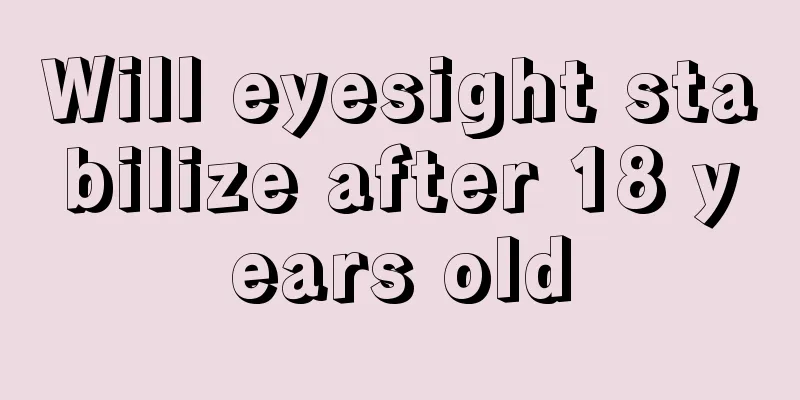Will eyesight stabilize after 18 years old

|
Vision is a very important visual health condition of the human body. Then normal people should have stable vision. However, some people may suffer from decreased vision due to bad living habits or other problems. Improving vision requires daily eye habits, and different changes will occur at a certain age. Will vision stabilize after 18? Generally speaking, for people aged eighteen, the development of various organs of the human body including the eyeballs has been finalized and stabilized, so the degree of myopia is not easy to change. However, a bad eye environment and bad eye habits will cause eye fatigue and also cause vision loss. It is not limited by age. It can only be said that the older you are, the less likely it is to get worse. In reality, there are many cases of people over the age of 20 whose myopia worsens due to excessive use of the eyes, especially excessive use of the Internet. There are even many people who did not have myopia before the age of 18, but developed myopia due to excessive use of the Internet after the age of 18. It is recommended to use your eyes correctly and not overuse them. Vision Standards Many people think that as long as the vision is above 1.0, it is normal. In fact, a visual acuity of 1.0 only means that a person's partial vision is normal. Strictly speaking, the standard for normal vision also includes the following: 1. Central vision: This is the vision that people usually determine by looking at the eye chart, including distance vision (looking at the eye chart at 5 meters away) and near vision (looking at the eye chart at 30 centimeters). Hyperopia is characterized by better distance vision than near vision; myopia is the opposite. People with astigmatism have poor distance and near vision. Only when the distance and near vision reaches 0.9 or above can it be said that the central vision is normal. 2. Peripheral vision: When the eyes are fixed on a certain target, the range that can be seen by the non-fixation area is large or small. This is called peripheral vision, which is also often called "peripheral vision". Generally speaking, a normal person's peripheral vision range is quite large, reaching 90 degrees on both sides, 60 degrees above, and 75 degrees below. Patients with myopia and night blindness have relatively poor peripheral vision, and some fundus diseases can also cause loss of peripheral vision. 3. Stereoscopic vision: Stereoscopic vision is the highest level of vision. That is, based on the normal central vision of both eyes, through the coordination of the two hemispheres of the brain, one can feel the distance relationship between objects in space. Some people have normal central vision but abnormal stereoscopic vision, which is medically called stereo blindness. Although we usually only check the central vision, in medicine, vision is considered normal only when the central vision, peripheral vision and stereoscopic vision all meet physiological requirements. Abnormal vision Shortsighted Seeing close objects clearly and distant objects blurry is professionally defined as "distant objects are focused in front of the retina after refraction by the eyeball, rather than forming a clear image on the retina." Myopia is the most common eye disease among Chinese children, and the rate of high myopia in mainland China is much higher than that among children in other countries and regions. Many eye diseases derived from high myopia are threatening the vision and eye health of many children. Hyperopia Nearby objects are refracted by the eye and focused on the retina, forming a blurred image on the retina. Therefore, patients with hyperopia cannot see clearly both near and far. Myopia is rare among infants and young children, but more than 90% of preschool children are hyperopic, most of which is physiological and a manifestation of normal eye development. 20% to 25% of hyperopia is pathological, which is the main cause of low vision and eye maldevelopment in children. amblyopia Amblyopia is a disease that seriously affects visual function. It refers to those people whose near and far vision is less than 0.8 and cannot be straightened without obvious organic lesions in the eye. According to statistics, there are more than 15 million people suffering from amblyopia, which has become a social problem that requires urgent attention. |
<<: Ear discharge becomes sticky and smelly
>>: What to do if blisters on tongue hurt?
Recommend
Sweating like crazy after taking a shower in summer
Summer is a time when we tend to sweat easily. Wh...
What is lung cancer? What are the symptoms of lung cancer?
Lung cancer is a common malignant tumor of the lu...
Four side effects of chemotherapy for ovarian cancer
In recent years, the incidence of ovarian cancer ...
What methods can be used to treat facial allergies?
Spring is about to officially begin, and many peo...
Which groups of people are prone to prostate cancer
Prostate cancer is one of the malignant tumors wi...
Oily outside, dry inside, large pores and acne
With increasing age, more polluted living environ...
What's wrong with the red bloodshot under the eyeball?
In our daily life, bloodshot eyes may appear due ...
How to remove rust from stainless steel
Stainless steel is known for its resistance to ru...
Is patellar dislocation serious?
Patellar dislocation usually occurs when there is...
Prostate cancer bone metastasis survival period
Prostate cancer is a highly malignant tumor disea...
Key points of dietary care after esophageal cancer surgery
As people's living standards continue to impr...
How long does it take to change the IUD?
Everyone knows that after installing an IUD, the ...
Residual urine volume in bladder after urination
Many people still feel that there is residual uri...
How to wear a wig
When a person is tired of looking at his or her h...
Can early stage lung cancer be cured by percutaneous intervention?
After the early stage of lung cancer occurs, inte...









